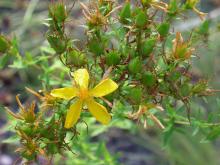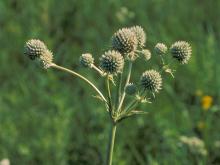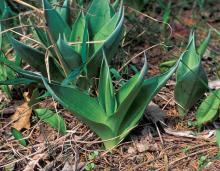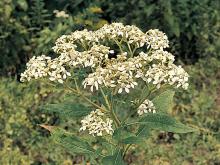Wildflowers, Grasses and Other Nonwoody Plants
Media

Species Types
Scientific Name
Hypericum perforatum
Description
In Europe, St. John’s-wort was long used as a medicinal herb and to ward off evil magic. Today, researchers are finding it can treat depression. Yet it poisons livestock and in some places is an invasive weed.
Media

Species Types
Scientific Name
Phytolacca americana
Description
A tall, smooth, branching plant with red stems and juicy, dark purple berries, pokeweed is both toxic and a traditional edible potherb called poke salat. It is common statewide.
Media

Species Types
Scientific Name
Lilium michiganense
Description
This native lily looks a lot like the Asian “tiger lily” that is commonly cultivated in gardens. Michigan lily, however, has leaves mostly in whorls and lacks the round “bulblets” that tiger lily forms in its leaf axils.
Media

Species Types
Scientific Name
Iris domestica (formerly Belamcanda chinensis)
Description
Blackberry lily has leaves like an iris, flowers like an Asian lily, and seeds that look like blackberries! Introduced as an ornamental, this self-seeding member of the iris family occurs on bluffs, roadsides, and old homesites.
Media

Species Types
Scientific Name
Tradescantia ohiensis
Description
Smooth spiderwort is the most common and widely distributed of Missouri's spiderworts. It has slender, straight or zigzag stems. The long, narrow leaves are folded lengthwise and attach to the stem in a thick node. The 3 petals of the triangular flower are blue, rose, purple, lavender, or white.
Media

Species Types
Scientific Name
Eryngium yuccifolium
Description
“It’s an odd plant,” this rattlesnake master, “with its leaves like yucca, a head like a thistle, and second cousin to the carrot.” That’s how the great prairie writer John Madson summed it up!
Media

Species Types
Scientific Name
Manfreda virginica (formerly Agave virginica)
Description
False aloe is one of the few native Missouri plants related to the agaves, or century plants, of the Southwest. Unlike agaves, a false aloe rosette can bloom and rebloom, and it doesn’t die after sending up a flowering stalk.
Media

Species Types
Scientific Name
Yucca smalliana, Y. glauca, and Y. arkansana
Description
Three species of yucca grow wild in Missouri. Spanish bayonet was introduced from the Southwest and has escaped from cultivation, but our two soapweeds are native.
Media

Species Types
Scientific Name
Verbesina virginica
Description
White crownbeard is a tall native perennial wildflower with clusters of white flowerheads. It's called “wingstem” for the narrow green wings running along the stem. It’s called “frostweed” because it forms "frost flowers": strange and beautiful formations at the stem bases after a sudden hard frost.
Media

Species Types
Scientific Name
Silphium laciniatum
Description
Compass plant grows to 8 feet tall and has foot-long, deeply cleft leaves at its base. It got its common name because its leaves turn so that the surfaces face east and west to take full advantage of the sun’s rays.
See Also
About Wildflowers, Grasses and Other Nonwoody Plants in Missouri
A very simple way of thinking about the green world is to divide the vascular plants into two groups: woody and nonwoody (or herbaceous). But this is an artificial division; many plant families include some species that are woody and some that are not. The diversity of nonwoody vascular plants is staggering! Think of all the ferns, grasses, sedges, lilies, peas, sunflowers, nightshades, milkweeds, mustards, mints, and mallows — weeds and wildflowers — and many more!





















